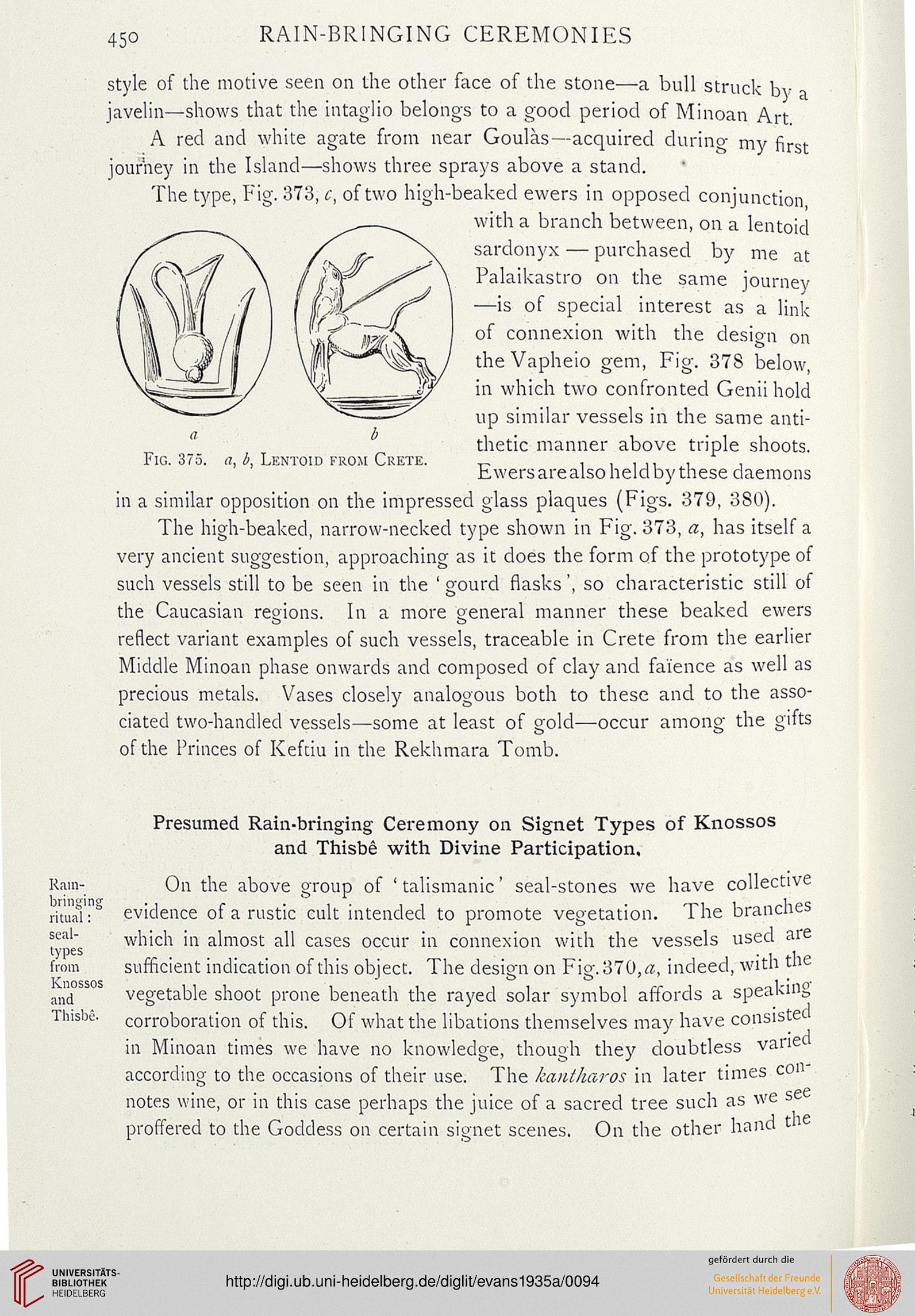45°
RAIN-BRINGING CEREMONIES
style of the motive seen on the other face of the stone—a bull struck by a
javelin—shows that the intaglio belongs to a good period of Minoan Art
A red and white agate from near Goulas—acquired during my flrst
journey in the Island—shows three sprays above a stand.
The type, Fig. 373, c, of two high-beaked ewers in opposed conjunction
with a branch between, on a lentoicl
sardonyx — purchased by me at
Palaikastro on the same journey
—is of special interest as a link
of connexion with the design on
theVapheio gem, Fig. 378 below,
in which two confronted Genii hold
up similar vessels in the same anti-
thetic manner above triple shoots.
Ewersarealsoheldby these daemons
<*, b, Lentoid from Crete.
in a similar opposition on the impressed glass plaques (Figs. 379, 380).
The high-beaked, narrow-necked type shown in Fig. 373, a, has itself a
very ancient suggestion, approaching as it does the form of the prototype of
such vessels still to be seen in the ' gourd flasks ', so characteristic still of
the Caucasian regions. In a more general manner these beaked ewers
reflect variant examples of such vessels, traceable in Crete from the earlier
Middle Minoan phase onwards and composed of clay and faience as well as
precious metals. Vases closely analogous both to these and to the asso-
ciated two-handled vessels—some at least of gold—occur among the gifts
of the Princes of Keftiu in the Rekhmara Tomb.
Rain-
bringing
ritual:
scal-
lypes
from
Knossos
and
Tllisbc.
Presumed Rain-bringing Ceremony on Signet Types of Knossos
and Thisbe with Divine Participation.
On the above group of 'talismanic' seal-stones we have collective
evidence of a rustic cult intended to promote vegetation. The branches
which in almost all cases occur in connexion with the vessels used aie
sufficient indication of this object. The design on Fig.370,<z, indeed, with tne
vegetable shoot prone beneath the rayed solar symbol affords a speaking
corroboration of this. Of what the libations themselves may have consiste
in Minoan times we have no knowledge, though they doubtless vane
according to the occasions of their use. The kantharos in later times con
notes wine, or in this case perhaps the juice of a sacred tree such as we se
proffered to the Goddess on certain signet scenes. On the other hand ti
RAIN-BRINGING CEREMONIES
style of the motive seen on the other face of the stone—a bull struck by a
javelin—shows that the intaglio belongs to a good period of Minoan Art
A red and white agate from near Goulas—acquired during my flrst
journey in the Island—shows three sprays above a stand.
The type, Fig. 373, c, of two high-beaked ewers in opposed conjunction
with a branch between, on a lentoicl
sardonyx — purchased by me at
Palaikastro on the same journey
—is of special interest as a link
of connexion with the design on
theVapheio gem, Fig. 378 below,
in which two confronted Genii hold
up similar vessels in the same anti-
thetic manner above triple shoots.
Ewersarealsoheldby these daemons
<*, b, Lentoid from Crete.
in a similar opposition on the impressed glass plaques (Figs. 379, 380).
The high-beaked, narrow-necked type shown in Fig. 373, a, has itself a
very ancient suggestion, approaching as it does the form of the prototype of
such vessels still to be seen in the ' gourd flasks ', so characteristic still of
the Caucasian regions. In a more general manner these beaked ewers
reflect variant examples of such vessels, traceable in Crete from the earlier
Middle Minoan phase onwards and composed of clay and faience as well as
precious metals. Vases closely analogous both to these and to the asso-
ciated two-handled vessels—some at least of gold—occur among the gifts
of the Princes of Keftiu in the Rekhmara Tomb.
Rain-
bringing
ritual:
scal-
lypes
from
Knossos
and
Tllisbc.
Presumed Rain-bringing Ceremony on Signet Types of Knossos
and Thisbe with Divine Participation.
On the above group of 'talismanic' seal-stones we have collective
evidence of a rustic cult intended to promote vegetation. The branches
which in almost all cases occur in connexion with the vessels used aie
sufficient indication of this object. The design on Fig.370,<z, indeed, with tne
vegetable shoot prone beneath the rayed solar symbol affords a speaking
corroboration of this. Of what the libations themselves may have consiste
in Minoan times we have no knowledge, though they doubtless vane
according to the occasions of their use. The kantharos in later times con
notes wine, or in this case perhaps the juice of a sacred tree such as we se
proffered to the Goddess on certain signet scenes. On the other hand ti





